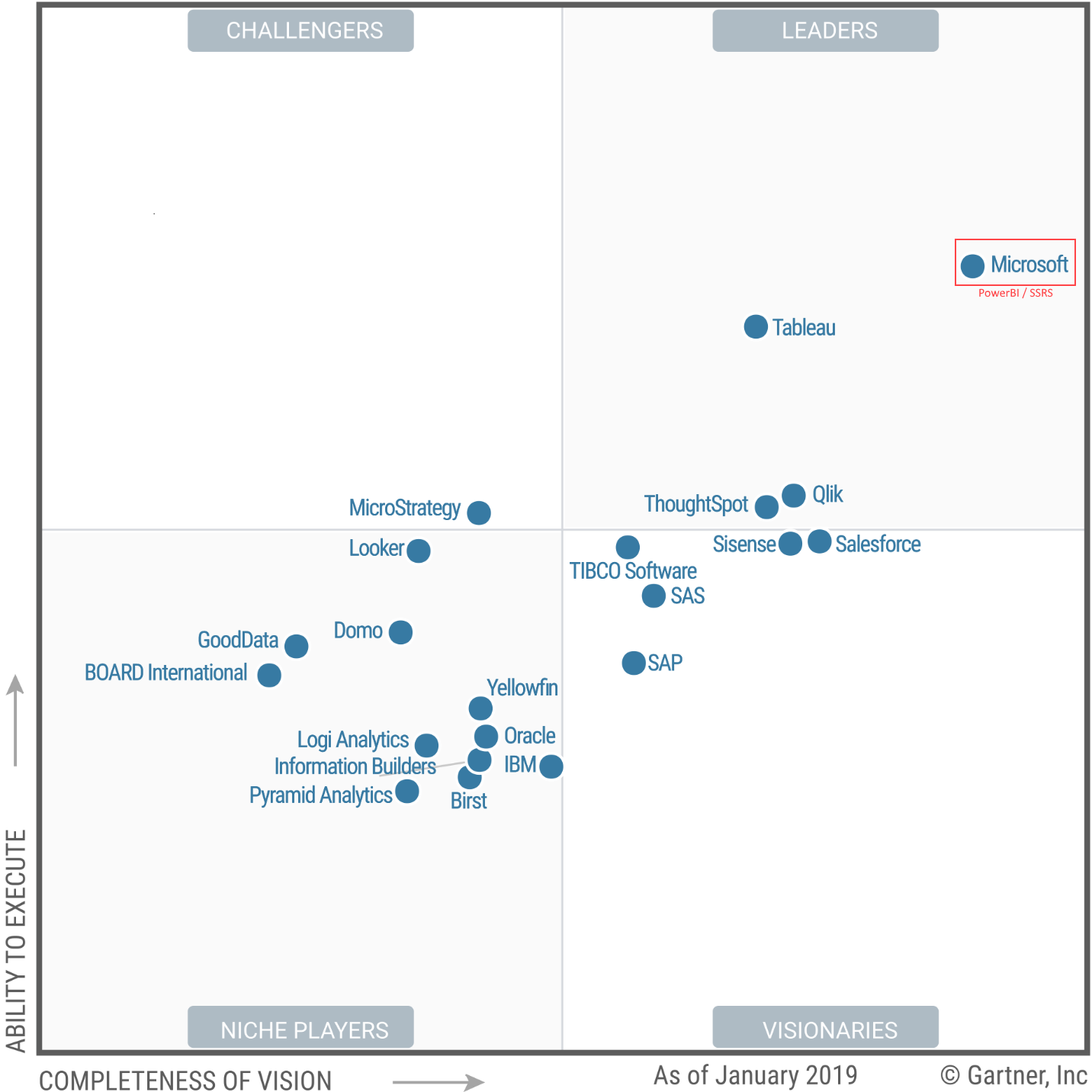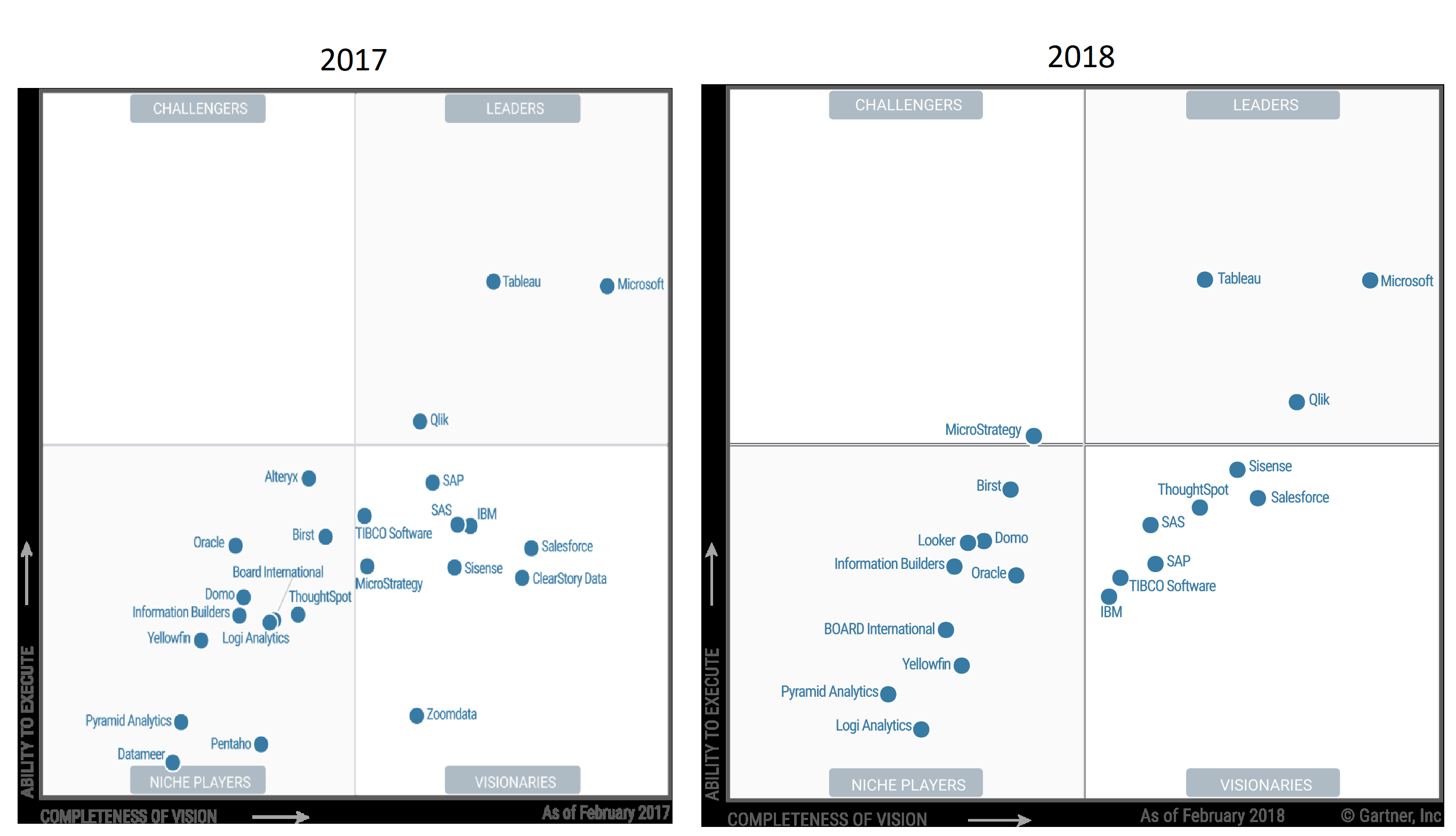先睹为快,看看你正在用的工具在哪里?
文末见2017-2018图

对比2019年,
1.ThoughtSpot好像发展很快
2.IBM......
3.Microstrategy好像表现还不错
4.Looker还有潜力,公司在融资
关于微软/PowerBI
Strengths 强项:
- Low-priced incumbent with positive sales experience: Microsoft has put downward pricing pressure on the analytics and BI market with its low per-user, virtual server subscription and embedded capacity-based pricing. Given that many organizations have Microsoft enterprise software agreements, even when Power BI is not yet deployed, it appears on most shortlists by default. License cost was the second most important reason for reference customers to choose Microsoft Power BI: More than 15% of them identified this as a reason for selecting this platform. Reference customers also put Microsoft in the top third of vendors in this Magic Quadrant for sales experience — an improvement on the previous year. 大意是:PowerBI拉低了数据分析工具的价格,很多公司都有微软的企业软件服务,PowerBI常常出现在采购的shortlist。
- Ease of use for complex types of analysis: Reference customers continue to recognize Microsoft for its ease of use — they gave it top-third ratings across all aspects of ease of use. Microsoft’s “first five-minute experience” (it aims to have users register for a trial and be “wowed” within five minutes) and a robust user community contribute to this result. Power BI supports complex data models with integrated advanced analytics. In an improvement over the previous year, Microsoft came in the top third for the use of its product for complex types of analysis.大意是:经过去年的进化,易用性排前三了。
- Comprehensive product vision: Microsoft is investing in a broad set of visionary capabilities and integrating them with Power BI. Investments include enhancements to augmented analytics and making new AutoML features available in Azure Machine Learning. Azure cognitive services, such as text, sentiment and image analytics and AI, will also be available through Power BI for use by people with minimal data science skills, among many others. Important roadmap items include full support for existing Reporting Services reports, a common and open data model, and open data preparation with data flows.大意是:微软砸很多的钱和程序猿来整合PowerBI和自家的其他产品,包括傻瓜式的数据科学(文本分析、图像识别,AI),数据流等等。。。
Cautions注意
- Differences in on-premises and cloud service with Azure cloud only: Power BI Report Server enables users to share reports (not dashboards) and lacks some of the ML capabilities found in Power BI SaaS. Users also report inconsistencies in the support of different data sources. Microsoft does not give customers flexibility to choose a cloud infrastructure as a service (IaaS) offering, instead running only in Azure. 大意是:PowerBI只能够在微软自家Azure上面跑(这很正常啊,靠这个收钱啊)PowerBI Report Server少了很多在线SaaS的功能:仪表板、机器学习等。
- Integration of Mode 1 and Mode 2: With Power BI, Microsoft has mainly focused on requirements for Mode 2 (agile, self-service) analytics. On-premises SQL Server Reporting Services meets the needs of Mode 1 (for scheduled, distributed reports). This has resulted in a two-product deployment with different capabilities and different deployment approaches. Reporting Services content authoring and report distribution in Power BI is on the short-term roadmap.大意是:两个产品不一样,PowerBI 集中在敏捷自助式分析(模式二),SSRS集中在定期分发等
- Multiple products: Although the core of Power BI is a self-contained product, Microsoft’s roadmap spans multiple products. For example, more robust conversational analytics is supported through the Cortana personal digital assistant. Data scale-up options require multiple products. Turnkey integration or “unification” is a focus of Microsoft’s roadmap and a work in progress.大意是:微软PowerBI发展蓝图,包括整合Cortana等。
附2017-2018
